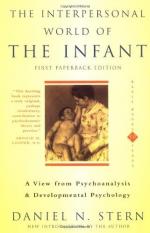
|
| Name: _________________________ | Period: ___________________ |
This test consists of 15 multiple choice questions and 5 short answer questions.
Multiple Choice Questions
1. The third organizing perspective produces a ______ during which time language points to knowledge of self.
(a) Domain of physical relatedness.
(b) Domain of resource relatedness.
(c) Domain of psychological relatedness.
(d) Domain of verbal relatedness.
2. During the seventh to ninth month of development, infants are ________, but they can still create experiences that are shared.
(a) Pre-visual.
(b) Pre-memory.
(c) Pre-movement.
(d) Preverbal.
3. Primary psychological needs for __________, according to Stern, may also play a role in the emergence of intersubjectivity.
(a) Movement.
(b) Relatedness.
(c) Acknowledgement.
(d) Help.
4. The domain of intersubjective relatedness arises from something called _______ attunement, according to Stern.
(a) Movement.
(b) Impact.
(c) Affect.
(d) Effect.
5. Self-_________ becomes tied to the behaviors of the self-regulating other because they occur together.
(a) Identity.
(b) Coherence.
(c) Understanding.
(d) Experience.
6. Stern believes that the infants have " ______ -like" experiences, yet they are based on a core self.
(a) Symbiotic.
(b) Fission.
(c) Probiotic.
(d) Fusion.
7. In the first eight weeks of life, Stern believes that infants form a sense of a/an ______ self.
(a) Emerging.
(b) Inspired.
(c) Capacitated.
(d) Created.
8. Self-___________ involves the sense of self that experiences affects and emotions, according to the author's findings.
(a) Agency.
(b) Affectivity.
(c) Coherence.
(d) Destruction.
9. _________ are often shared around infants as well through protolinguistic forms, according to Stern.
(a) Movements.
(b) Intentions.
(c) Stories.
(d) Excuses.
10. ________ is the idea that the infant's self concept is created by or at least altered by the narrative that she receives.
(a) Proclivity.
(b) Reactivity.
(c) Creativity.
(d) Passivity.
11. The observed infant consists of the ________ that the infant demonstrates while under observation.
(a) Behaviors.
(b) Thoughts.
(c) Dreams.
(d) Subjective experiences.
12. Stern asserts that there are some elements of the sense of self that exist prior to language use including all of the following except ______.
(a) Physical cohesion.
(b) Sense of agency.
(c) Temporary continuity.
(d) Permanent continuity.
13. There is little evidence showing that psychological insults and ______ at one age predict later clinical problems.
(a) Ideas.
(b) Trauma.
(c) Attitudes.
(d) Development.
14. According to the book, recent research indicates that the infant is capable of having a sense of self and ______.
(a) Others.
(b) Thoughts.
(c) Emotions.
(d) Body.
15. Unlike other thinkers in the field, the author suggests that each developmental stage is ______.
(a) Discarded as the new one begins.
(b) Destroyed.
(c) Separate and discrete.
(d) Integrated into the others.
Short Answer Questions
1. According to the book the author is both a psychoanalyst and a _______, one who studies child development.
2. Freud hypothesized several developmental stages including all of the following except ______.
3. According to the book, the ______ infant was thought to be connected to the social world.
4. According to the book, infants seek ______ and have innate biases about the kinds and amount they seek.
5. Evidence is beginning to show that _________ can recognize the intersubjective stages in others as well.
|
This section contains 435 words (approx. 2 pages at 300 words per page) |

|




